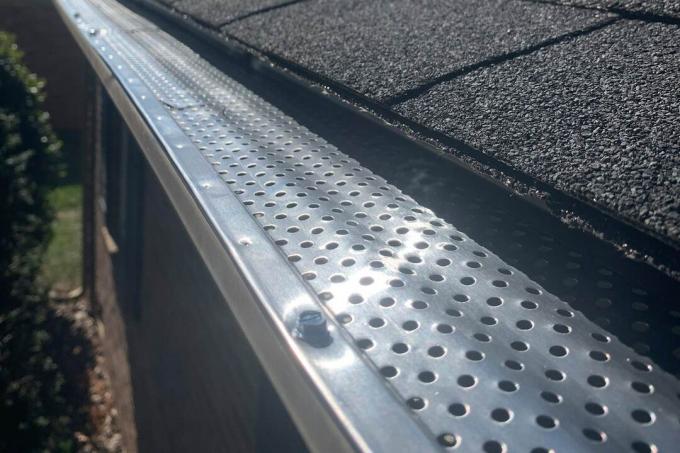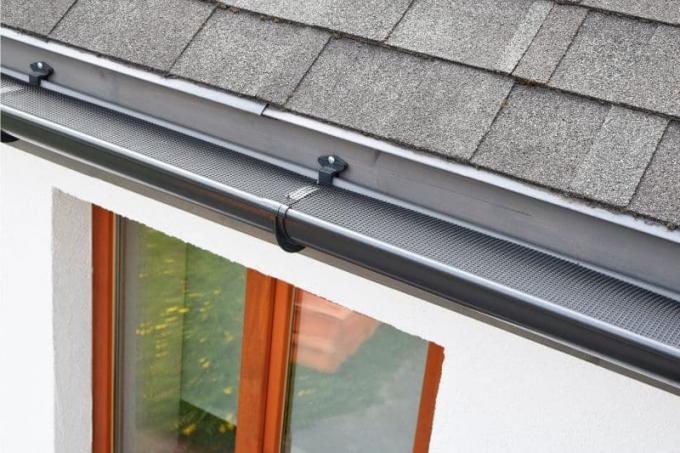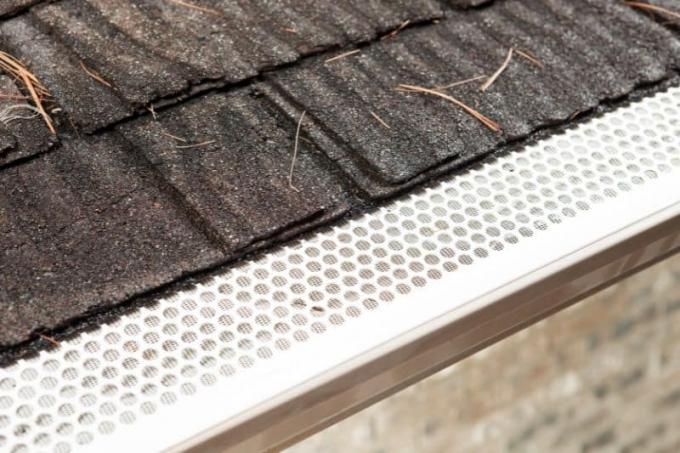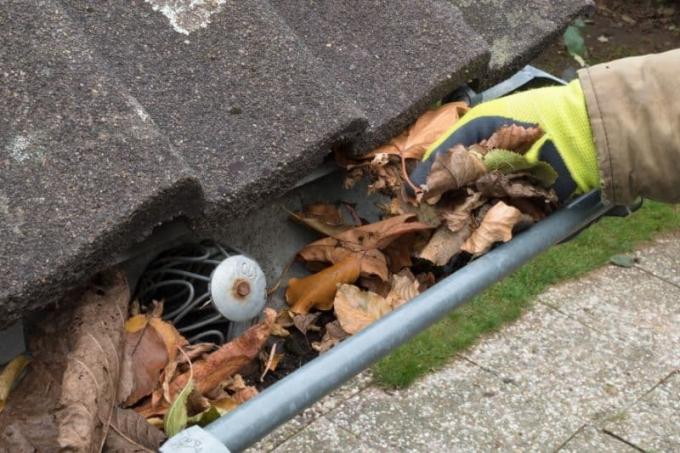
To ensure that rainwater can flow away promptly, clean gutters and clear drainpipes are essential. Unfortunately, they can become clogged with fallen leaves. The right leaf protection saves the homeowner from tedious and time-consuming tasks Cleaning the gutter.
To the point
- Metal or plastic grille
- Fastening by soldering, screws or clips
- Wire brushes for inserting/filling the gutter
- Cover dome for downpipes, made of metal or plastic
- Cost-effective alternative: self-made cover made of wire mesh
- Maintenance protects against follow-up costs through renewals
Table of contents
- Complete coverage
- Metal cover plates
- Metal grille with clip
- Plastic cover plates
- Curved cover grille
- Flexible cover grille
- Use for the gutter
- Cover for the downpipe
- Leaf catcher made of stainless steel
- Plastic leaf catcher basket
- Homemade cover
- frequently asked Questions
Complete coverage
With this leaf protection method, the open side of the gutter is covered over its entire length so that no more leaves can fall in. Of course, the cover is perforated so that rainwater can flow into the gutter. Various cover plates are offered.
Metal is a sturdy material that you rarely need to repair. Metal covers are particularly suitable for regions where heavy rains and storms are regularly expected in autumn. Among the metals used, stainless steel and aluminum are particularly weather-resistant.

- long service life, hardly any wear
- high assembly effort: screws or soldering
- thin sheets from 3 EUR per m; thick quality sheets 20 to 50 EUR per m
- Fastening material may need to be be purchased additionally
- Difficult to access for cleaning after installation
Our tip: Gutters are also usually made of metal. Before you attach a metal cover here, you should definitely check whether the two metals are compatible. Otherwise, one of the materials will corrode over time.
There are also metal grilles that are easier to assemble. You can attach the individual grid sections to the edge of the gutter with clips. While a specialist company may have to come and pay for soldering and screwing, this type of cover can also be installed by laypeople.

- low assembly effort
- Grilles can be removed quickly and easily for cleaning
- The stability of the attachment may decrease
- from 3 EUR per m
Plastic cover plates
You can use plastic with all gutters, regardless of what metal they are made of. The material has no influence on the lifespan of the gutter.

- low weight
- inexpensive; from EUR 2.50 per m
- weathers and becomes brittle
- Shelf life only a few years
- Low installation effort, fastened with clamps
Curved cover grille
Instead of using flat plates you can gutter also protect with round or roof-shaped cover grilles. The shape helps ensure that leaves do not remain lying there but slide off. Assembly is similar to flat panels.

- from EUR 5.50 per m
- less cleaning effort
- possibly. Grid visible from outside
Flexible cover grille
Flexible grilles can be easily bent into almost any desired shape. They can also be installed by laypeople using simple tools.
- plastic or metal
- cheap from EUR 1.50 per m
- easy to cut
- may require individual attachment
- not as durable as solid, thick panels
Our tip: With a little craftsmanship, you can “make” an inexpensive leaf guard yourself from simple wire mesh.
Use for the gutter
Instead of completely covering the gutter, you can simply “fill” the cavity with something so that no leaves more can fall in. That something is usually a wire brush. It consists of a long, flexible metal rod on which long bristles are attached close together. However, you can only attach the brush to its shape so that it is visible. Since the brush is round, it is particularly suitable for semi-circular gutters. Cover plates are more suitable for square gutters.

- Low acquisition costs from EUR 4.50 per meter
- must be selected precisely
- easy installation with securing clips
- easy to remove, reusable
- regular cleaning required
Our tip: The brush is also suitable for smaller wild animals from climbing onto the roof.
Cover for the downpipe
The narrow downpipes through which the Rainwater is directed into the sewer system or rain barrel, are particularly susceptible to blockages by leaves. If a leaf protection cover that has already been installed does not also cover the drain openings, you will need to protect these additionally.
Leaf catcher made of stainless steel
The metal leaf catcher basket available on the market already has an optimal dome shape. All you have to do is insert it into the opening of the downpipe. You can combine the cover with different gutter covers.

- a separate cover per hole
- no attachment required
- weather-resistant and durable
- from 9 EUR per piece
- must be cleared of accumulated leaves
Plastic leaf catcher basket
The functionality of the plastic cover does not differ from the stainless steel version. However, there are differences:
- from EUR 2.50 per piece
- not weatherproof
- needs to be renewed every few years
- can slip more easily in strong wind/cleaning
Homemade cover
If you have a piece of rabbit wire available, you can use it to make a reasonably stable dome for the downpipe. It must be tightly meshed enough to contain even small leaves and be able to be securely attached to the downspout entrance.

- very inexpensive, can be made from leftover material
- requires a good mounting solution
- may allow some leaves through
- visually not appealing
frequently asked Questions
In principle, you can install leaf protection systems at any time of the year. However, leaf protection should be installed by early autumn at the latest. Most trees shed their leaves between autumn and the beginning of winter. Anyone who acts later must expect extensive cleaning work before installation.
This approach is certainly possible and is also practiced. The advantages lie in the low costs and the low effort required for installation. However, this is a very minimalist form of leaf protection that only works if the gutter is also cleaned regularly. It is only recommended for roofs where there are no trees in the immediate vicinity.
An extractor hood is used for pipes from which unpleasant odors can escape. For example, because wastewater flows through them. Extractor hoods are also available for gutters. But they are actually not necessary as they only run outside the house.
The holes in the cover should not be too fine so that the water can seep away easily. On the other hand, the holes must be small enough so that no leaf can fall through. Also decide which trees are nearby. Deciduous trees with large leaves or conifers with fine needles.
